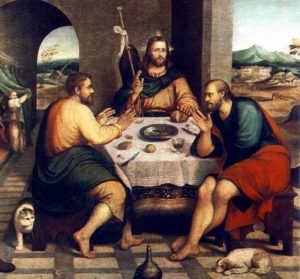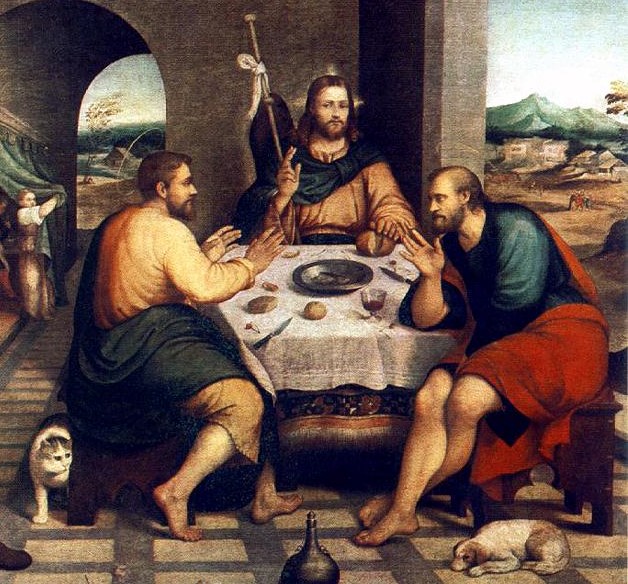
The liturgy begins with two disciples gathering as they make their way to Emmaus, just as we pilgrims gather for Mass. Jesus joins them, just as Jesus joins us in the opening procession and greeting by the celebrant. Jesus engages them in a sort of penitential rite by asking them what they were discussing on their journey and why they look so downcast. After hearing their complaints, He engages them in a kind of Liturgy of the Word, as He both quotes and explains scriptures to them. The Liturgy of the Eucharist follows, as Jesus take the bread, blesses it, breaks it, and gives it to them. It is then that they recognize Him, that the Bread He gives them is His very self. In a kind of Ite missa est (rite of dismissal) they go forth joyfully to share what they have seen and heard. Yes, the basic structure of the Mass is there.
Beyond the structural elements, the Emmaus Gospel also sets forth some of the expected fruits of Holy Mass. Let’s consider some of them.
I. Course Correction (conversion) – As the story begins the two disciples are traveling in precisely the wrong direction. Christ rises in the East, in Jerusalem, but they are headed West, away from Jerusalem, away from the Lord and His Body the Church, which is gathered and already announcing the truth of the resurrection. It’s never a good thing to have your back toward the heavenly Jerusalem or the Church, which is Heaven’s outpost and doorway. The effect of the “Mass on the move” will be to have them turn and “re-turn” toward Jerusalem and toward the Church gathered in the growing light of the resurrection. They return that very evening.
For us, too, the goal of the liturgy is our ongoing conversion, our increasing turning to the East, to the light, to the resurrection, and to the Body of Christ gathered—the Church.
II. Fuller Fellowship (koinonia) – Whatever their struggles, at least the disciples on the road to Emmaus are not alone; they are together and pondering the events of the Lord’s paschal mystery. Jesus said, Where two or three are gathered in my name, there am I in the midst of them (Mat 18:20).
This is an important antidote to the tendency of many (especially among the Protestants) to reduce the faith to a “Jesus and me” experience. Many speak of Jesus as their “personal Lord and Savior.” He is surely that, but this description can easily miss the communal aspect of the faith: that Jesus is Shepherd of the flock. The Lord has a Body, the Church, with many members.
By insisting that we gather, at a minimum each Sunday at Mass, the Lord and the Church dictate that we not walk alone. As we walk together, Jesus joins us and journeys with us.
This “fellowship” is about more than coffee and doughnuts. It is about a shared liturgical experience, a shared instruction in the faith and in the Sacrament of Holy Communion that unites us to the Lord and to one another. When the “Mass on the move” is complete the disciples say, “Were not our hearts burning within us as he spoke the word to us?”
They then return to Jerusalem to join the wider fellowship of the Church gathered there to share their experience and have it affirmed by others. All of this indicates a fuller fellowship, which the Lord expects of us. He expects that we maintain communion with His Body, the Church. Our celebration of Mass in our parishes should unite us to the wider Church throughout the world and across time.
III. Transformative Teaching – The two disciples go from being downcast to having their hearts set on fire. They go from blindness to seeing, from confusion and doubt to clarity and deeper faith. The Lord accomplishes this for us in the Mass by Word and Sacrament.
Consider, first, the Liturgy of the Word. After hearing their concerns and fears, Jesus applies His word, quoting Scripture extensively and explaining it. This sets their hearts on fire and brings clear light to their minds. So, too, for us if we faithfully attend to the Liturgy of the Word. We may come with many doubts, fears, questions, and concerns, but a lifelong formation in the Word of God through the Liturgy of the Word sets our hearts ablaze and clears our minds, which are darkened by sin and worldliness.
The Word of God is a prophetic declaration of reality. It says to us, “Regardless of what you think is going on, this is what is really happening.” Scripture is replete with stories of victory for those who remain faithful. Its steady message is what Jesus says: In this world you shall have tribulation, but have confidence, I have overcome the world (Jn 16:33; Rev 2:10).
This is a vision for our life and a roadmap of ultimate victory if we remain faithful unto death. Formed in this word that the Messiah would suffer but rise on the third day, the disciples move from gloom to glory.
We, too, formed by a steady diet of God’s Word, will see our hearts encouraged and set ablaze, our minds instructed and brought to the light.
IV. Deepening Disclosure – The text says that the disciples’ eyes were opened, and they recognized the Lord in the breaking of the bread. Even as the Liturgy of the Word accustoms us to the Lord’s voice and His wisdom, the Eucharist accustoms us to recognize Him, not only in the Eucharistic elements but in our lives and throughout our day. Through our coming to know Him in Word and Sacrament, we grow spiritually and are able to remain in living, conscious contact with Him throughout every day. We learn of Him in the liturgy and thereby recognize Him active in creation—in the events of our lives and in the people we encounter.
V. Promised Presence – As soon as they recognize the Lord Jesus in the Breaking of the Bread, He vanishes before their eyes. Here, the Lord teaches them that they will not see Him in the earthly way; now they will see Him in the Sacraments and encounter Him in the liturgy.
This teaching is important for us, too. Some seek visions or invocations; others go to mountaintops or deserts to find Jesus. Good though such settings are for quiet prayer, the Lord is not so far away. He need not be sought in visions and invocations. He is as near as the closest tabernacle, as the nearest liturgy.
In Holy Mass or any other liturgy, the Lord speaks to us and ministers to us. He is present in those who gather, in the Word proclaimed, in the priest who celebrates, and above all in the Eucharistic elements. The gift of the Liturgy is Christ Himself.
VI. Exuberant Evangelization – The disciples are then filled with joy and zeal to share what they have seen, heard, and experienced. When one is joyful, one doesn’t need to be told how to share the good news; it comes naturally. When we hear good news we instinctively want to tell others.
These disciples cannot wait to rejoin the others to proclaim what and whom they have seen and experienced. If we are open to experience the Lord, we too will exuberantly go forth to tell others.
When the priest or deacon says, “The Mass is ended. Go in peace,” He is not simply saying, “Go home now and have nice day!” He is saying, “Go tell people what you have seen and heard. Tell them that you encountered the Lord. Tell them what the Lord said and how He fed you. Tell them what He has done for you!” Even if every Mass does not have this effect on you, can’t you at least tell people what a difference going to Mass has made in your life?
How is it possible to encounter the Lord and not come away with joy and a zeal to tell others? Yet many do just that. Moribund and perfunctory celebrations of the Liturgy do not help, of course. A little fiery preaching and the devout celebration of the Eucharist help. All of us need to be more aware what the Mass is; we must go with high expectations of meeting the Lord!
These, then, are some fruits of the liturgy set forth by today’s Gospel about the disciples on the road to Emmaus.
The video below does a good job of imagining some of the Scriptures that the Lord broke open for them. (The Eucharistic dimension is less well developed.)

